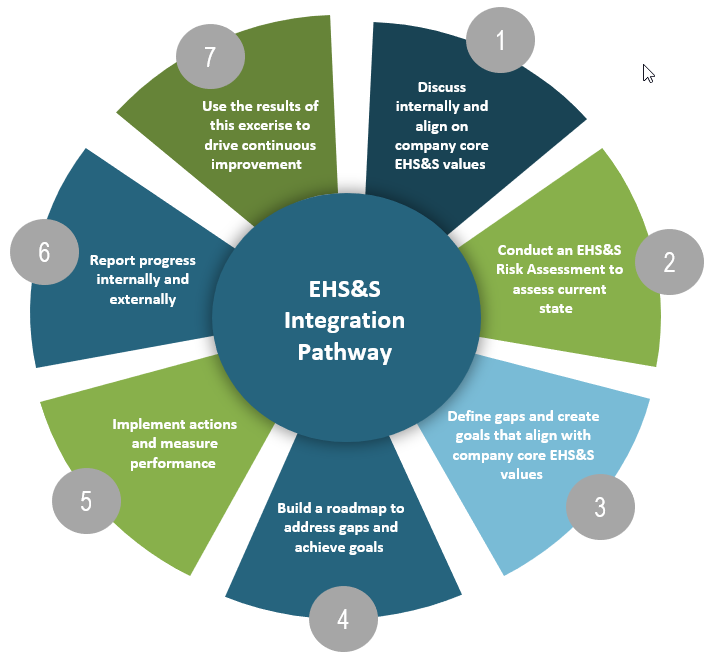When starting a company, every penny must be invested wisely until a solid market niche is established. With limited funds, market disruptions like COVID19 can be and has been the end of many new endeavors. However, companies with routine environment, health, and safety (EHS) compliance programs and procedures are able to minimize the financial impact of these disruptions.
Investing early into a scaled EHS program can ensure risks are properly managed and systems are in place for managing the unexpected. The return on the investment of EHS compliance is commonly understood due to the regulatory drivers. Antea Group would argue that adding sustainability goals or projects is also ideal when starting a company.
With consumer habits changing due to new shopping behaviors as more and more people are taking a deeper look at what they apply or put in their bodies, as well as the hyper-focus placed on environmental, social, and corporate governance (ESG) performance, companies need to be able to control their narrative. By evaluating environment, health, safety, and sustainability (EHS&S) risks and opportunities and working to improve EHS&S culture and performance, companies can position themselves for growth. This will not only satisfy external stakeholders such as customers and investors but also increases employee satisfaction and talent retention. To dive into a more tangible example, let’s look at a strong trend in the Food and Beverage (F&B) Industry.
Food and Beverage Industry and Alternative Meat Growth
The Food and Beverage industry has not only been forced to adapt in a major way to all the challenges and changes that COVID-19 has created. F&B companies are also adjusting to the increasing demand for products that are perceived as healthier and more environmentally friendly. Case in point: the market for alternative meat products is exploding.
Plant-based food sales that directly replace animal products has grown 29% in the past two years to $5 billion in the U.S. Why this tremendous growth? In the last 2 years alone, innovations have improved the taste and texture of alternative meat and dairy products making them more appealing to traditional meat-eating consumers. Reports of fast food companies running out of fresh beef and grocery stores restricting meat sales during the COVID-19 pandemic also fueled this growth. Grocery store sales of alternative-meat products rose by 264% in the nine weeks ending May 2, 2020, a $25.7 million increase and faster than they were growing before the crisis hit the U.S.
Integrating EHS&S for Continued Growth and Success
Many well-known food and beverage companies have recognized this shift and have adapted to meet the changing market needs. While these big names have established success in this niche market, the market is seeing big disruption from startups, some of which are within the top 10 list of fastest-growing food companies. So, how does a fast-growing, innovative company that is breaking barriers ensure their chance of continued success? Besides the obvious of having stellar products and an effective marketing strategy, startups (of any industry) should place equal importance on protecting their employees, the planet, and their license to operate.
Integration of EHS&S within your startup business can help to:
-
Protect employees through the cultivation of safe work areas and practices
-
Avoid penalties and legal prosecution of leadership in the event of an environmental or health and safety incident at their facilities
-
Generate a “green” brand and/or prevent reputational damage
-
Lead to positive metrics and results that are reported to their customers and stockholders requesting EHS&S performance information
-
Support productivity by promoting a safe, diverse, and healthy work environment
-
Attract and retain top talent
-
Create long-term value by appealing to all stakeholders (investors, employees, communities, suppliers, and customers)
Reducing Risk and Bolstering Business Resiliency
We recognize that startup companies can have a lot of growing pains and competing priorities. In addition to inventing new products, they experience hiring frenzies, and are constantly managing change and solving problems. It is important that these fast growing companies understand their risk exposure and build a strategy that is tailored to their needs.
To build a fit-for-purpose EHS&S strategy that reduces risks and bolsters business resiliency, we recommend the following 7 steps:
- Discuss internally with key stakeholders that represent all employee functions and align on company core EHS&S values.
- Conduct an EHS&S Risk Assessment to assess the current state of your operations.

- Define compliance and cultural gaps and create goals that align with company core values.
- Build a roadmap of actions to address gaps and achieve goals.
- Implement actions and measure performance through leading and lagging key performance indicators.
- Report progress internally and externally to tell the story.
- Use the results of this exercise to drive continuous improvement within your organization.
While legally a startup must comply with EHS requirements, using these seven steps will foster more engagement with your employees and create an EHS&S culture to serve as the company’s backbone of operations. The culture of EHS&S engagement with your employees will assist in risk mitigation in the workplace, innovation in how to control risks, and reduce natural resource consumption. Often EHS&S is put on the back burner as something to do once the company is nationally known, but it shouldn’t be. Rather, having EHS&S procedures, training, goals, and metrics in the forefront as your company grows will send the right message from the start to all your stakeholders.
How We Can Help Reduce EHS&S Risks
At Antea Group, we are dedicated to supporting all of our clients from startup to decommissioning in their efforts to reduce EHS&S risks. We do this by offering clients consulting support that meets their needs – whether it is help with strategy or goal-setting, executing on projects, or telling your story – we are here to help from strategy through implementation. We are also here to cover our clients’ blind spots. We understand that EHS teams can sometimes be understaffed or under-resourced and that you may need help communicating to the C-suite regarding the importance of investing in EHS&S.
Read more about how we provided an alternative meat company with on-site support and technical expertise to accomplish tasks related to their health and safety goals.
Go To ProjectWant more news and insights like this?
Sign up for our monthly e-newsletter, The New Leaf. Our goal is to keep you updated, educated, and even a bit entertained as it relates to all things EHS and sustainability.
Get e-NewsletterHave any questions?
Contact us to discuss your environment, health, safety, and sustainability needs today.






